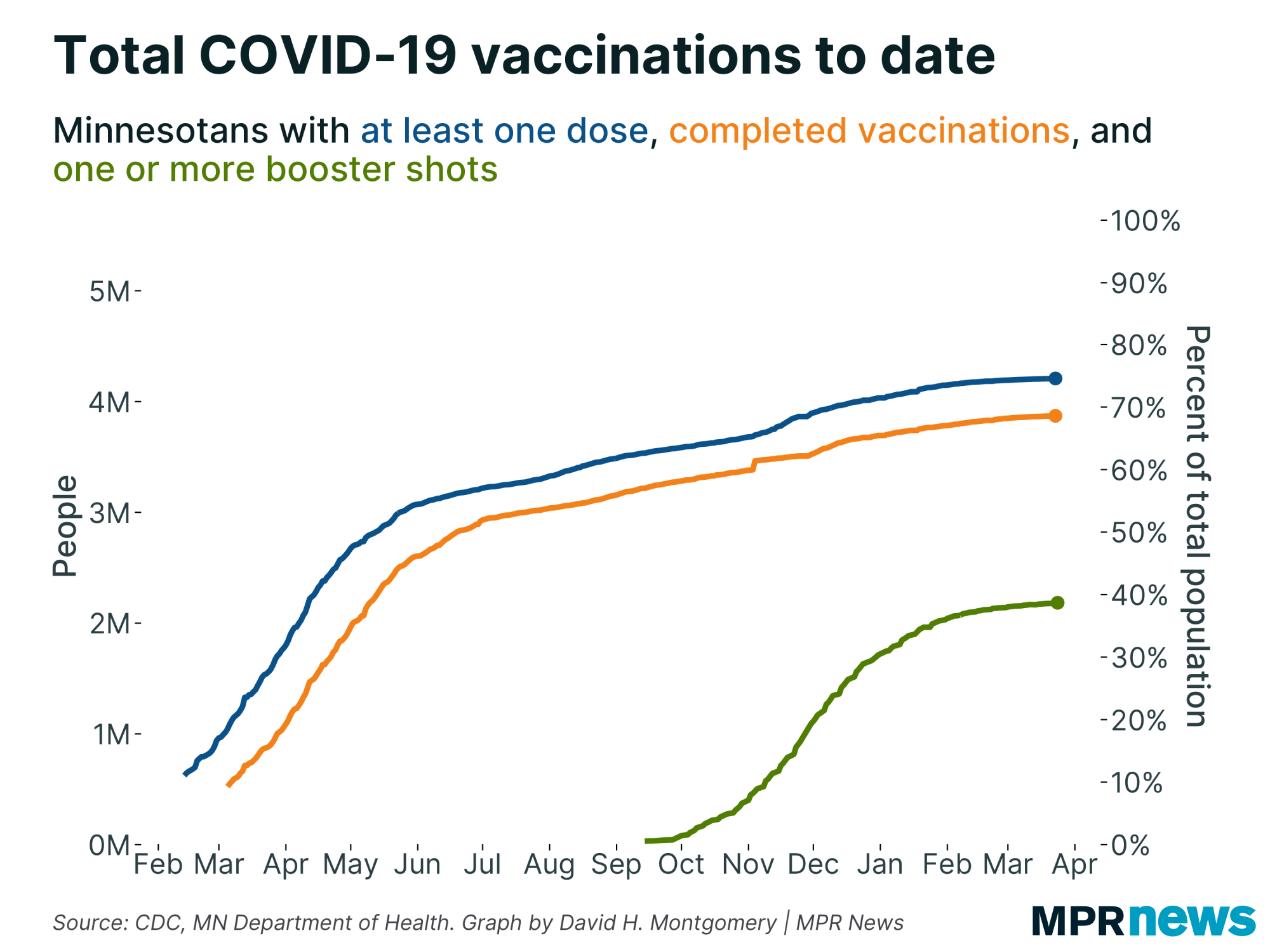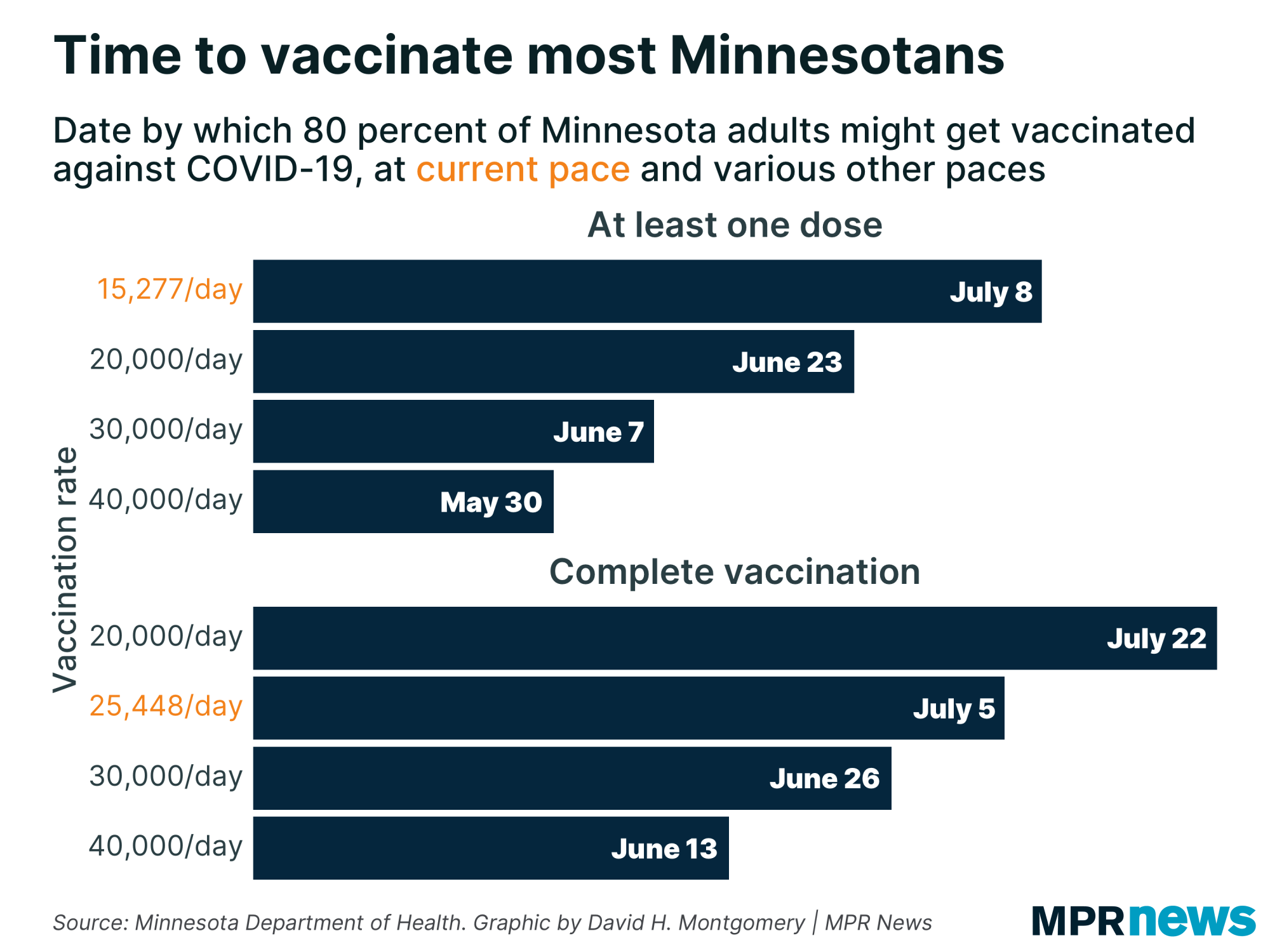April 28 update on COVID-19 in MN: Active cases receding; Walz eyes looser curbs

Go Deeper.
Create an account or log in to save stories.
Like this?
Thanks for liking this story! We have added it to a list of your favorite stories.
3 things to know
Active caseloads retreating; Walz plans more loosening of restrictions
About 56 percent of Minnesotans 16 and older have received at least one dose; 42 percent completely vaccinated
First grader died from COVID-19 complications
Updated: 5:40 p.m.
The state’s newest COVID-19 numbers offer more evidence that the recent upswing in cases may have crested.
Active caseloads are ebbing to the point that Gov. Tim Walz on Tuesday said he plans to announce another easing of COVID-19 restrictions in the coming days, likely an increase in capacity limits in bars, restaurants and other public indoor gathering spaces.
Even as the latest wave ebbs, state officials continue to urge Minnesotans to keep their guard up to protect against spreading the virus, noting that more contagious COVID-19 variants continue to drive new cases in the region.
“The impact of the variants remains a wild card,” Minnesota Health Commissioner Jan Malcolm told reporters Wednesday. “We’re certainly hopeful with the recent apparent kind of leveling off in the case rates, although still at a very high level. We’re certainly not declaring victory yet.”
Turn Up Your Support
MPR News helps you turn down the noise and build shared understanding. Turn up your support for this public resource and keep trusted journalism accessible to all.
The count of known, active cases came in at just under 14,000 in Wednesday’s numbers — the lowest since March 31 and down from the most recent peak of about 20,000 in mid-April.

Given the state’s vaccination efforts, officials said they didn’t expect this spring wave would match the 50,000 active cases seen at the top of the late November surge, but they remained worried given the rise in new COVID-19 strains.
The percentage of COVID-19 tests coming back positive continues to dip after a recent upswing. The trend line on Wednesday remained just below the 5 percent threshold that experts find concerning.
Hospitalizations had been climbing the past few weeks, hovering at levels not seen since January.
Wednesday’s numbers showed 643 people hospitalized with COVID-19 in Minnesota; 178 needed intensive care. Both figures are down from the prior week. Hospitalizations often stay higher for several weeks following an increase in active cases.
Twenty-two deaths reported Wednesday brought Minnesota’s pandemic toll to 7,113. Among those who have died, about 61 percent had been living in long-term care or assisted living facilities; most had underlying health problems.

The state has recorded 572,025 total confirmed or probable cases so far in the pandemic, including the 1,514 posted Wednesday. About 96 percent of Minnesotans known to be infected with COVID-19 in the pandemic have recovered to the point where they no longer need to isolate.

Regionally, all parts of Minnesota are in better shape than they were in late November and early December. Case counts had been creeping up the past few weeks across the state, but the trend appears to have peaked.

Vaccination pace leveling out
Minnesota’s vaccination pace remains relatively flat as officials work now to reach out to those who haven’t been vaccinated.
Nearly 2.5 million residents 16 and older now have at least one vaccine dose, and more than 1.8 million have completed their vaccinations, as of Wednesday’s update.
That works out to about 42 percent of the 16-and-older population completely vaccinated and 56 percent with at least one shot, including more than 86 percent of those 65 and older. The state is still on track to hit 80 percent of adults to be fully vaccinated by the Fourth of July, according to current projections.

The state’s vaccination efforts have been hampered the past few weeks by supply cuts, particularly of the Johnson & Johnson vaccine, which federal authorities paused earlier this month as they investigated the possibility of rare side effects associated with the shot.

The pace may pick up, after federal health officials lifted the pause on using the Johnson & Johnson vaccine. But the recent production breakdown that resulted in millions of J&J doses ruined is having an impact.
Officials also acknowledge the state must do more to get vaccines to people.
“We’re at a place now where people are not coming to us for the vaccine. We have to bring it to them,” Ehresmann, the state’s infectious disease director, said Wednesday. The next phase of vaccination involves “needing to meet people where they’re at, and much closer to home.”
Ehresmann added that there might be some hesitancy, but the bigger issue is whether people have ample opportunity to get vaccinated within the restraints of their work or ability to travel.
She said about 3.4 percent of Minnesotans who’ve received their first dose of a two-dose regimen are late for their second shot. Nationwide, about 8 percent of Americans have skipped out on their second dose, according to the Centers for Disease Control and Prevention.
Youth counts a concern
While the numbers are improving, officials continue to emphasize the pandemic is not over.
Minnesota officials say they want more testing of middle and high school students because they’re increasingly concerned about the spread of COVID-19 in younger people, particularly those playing youth sports.
State health and education officials have posted updated guidance urging athletes, coaches, referees, volunteers and other youth sports participants to get tested weekly for COVID-19.
Students not participating in sports or other group activities are “still strongly encouraged” to test every two weeks, they said. Middle and high schools are being advised to offer on-site testing.
People in their 20s still make up the age bracket with the state’s largest number of confirmed cases — more than 106,000 since the pandemic began.
The number of high school-age youth confirmed with the disease has also grown, with more than 46,000 15-to-19-year-olds known to be infected during the pandemic.
Although young people are less likely to feel the worst effects of the disease and end up hospitalized, experts worry they will spread it unknowingly to older relatives and members of other vulnerable populations. Those with the COVID-19 virus can spread it when they don’t have symptoms.
Walz: Child’s death ‘simply heartbreaking’
The brightening metrics this week have come with a sad reminder of the pandemic’s pain: A first grader in southwestern Minnesota with no underlying health problems died Sunday from COVID-19 complications.
More than 56,000 kids age 14 and under in Minnesota have tested positive for COVID-19 since the pandemic began. More than 400 of those children have been hospitalized; 99 have been admitted to intensive care. Three children have now died from complications of the disease.
“It is simply heartbreaking to hear that COVID-19 has taken the life of someone so young,” Walz said in a statement. “My thoughts are with the Minnesota family grieving the loss of their beloved child. There is no grief more profound than the loss of family.”
Latest developments
Walk-in vaccinations now available at fairgrounds
Health officials say they're opening up COVID-19 vaccinations at the State Fairgrounds.
The mass vaccination site has already been offering appointments for people in surrounding ZIP codes. But a spokesperson for the State Department of Health says the site is now taking walk-ins for first doses without appointments through May 4. Eligibility is no longer limited by ZIP code.
The fairgrounds previously limited walkups to just 100 a day, but now has no limit beyond the 2,000 daily doses it has available.
— Tim Nelson | MPR News
St. Paul Public Schools extends free meal program
St. Paul Public Schools will continue its free meal program through the summer.
The district initially started delivery and pickup options when the pandemic forced schools to close to students. The meals will be available to anyone age 18 and younger at dozens of locations.
Delivery is offered for children and young adults with medical or transportation issues.
— Tim Nelson | MPR News
Top headlines
Benefits outweigh the risks of Johnson and Johnson vaccine, Dr. Hallberg says: Officials at the U.S. Centers for Disease Control and Prevention have allowed providers to resume administering the one-dose vaccine, after reviewing the rare risk of blood clots associated with it.
Pandemic-fueled surge in visitation to BWCA expected to continue this year: Amid COVID-19, more than 165,000 people visited the Boundary Waters last year — a 16 percent jump over the previous year — as people sought refuge in the isolated wilderness from the pandemic. Outfitters say early reservations suggest this summer could be even busier.
COVID-19 in Minnesota
Data in these graphs are based on the Minnesota Department of Health's cumulative totals released at 11 a.m. daily. You can find more detailed statistics on COVID-19 at the Health Department website.


